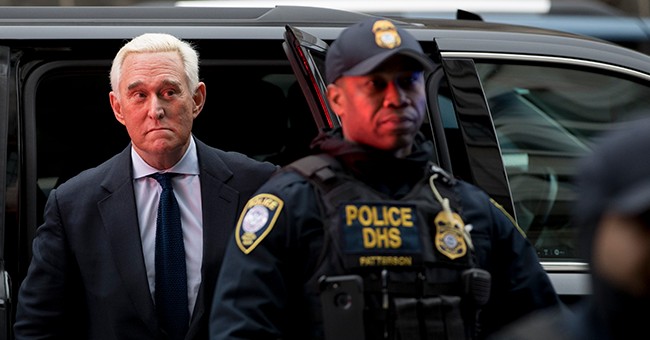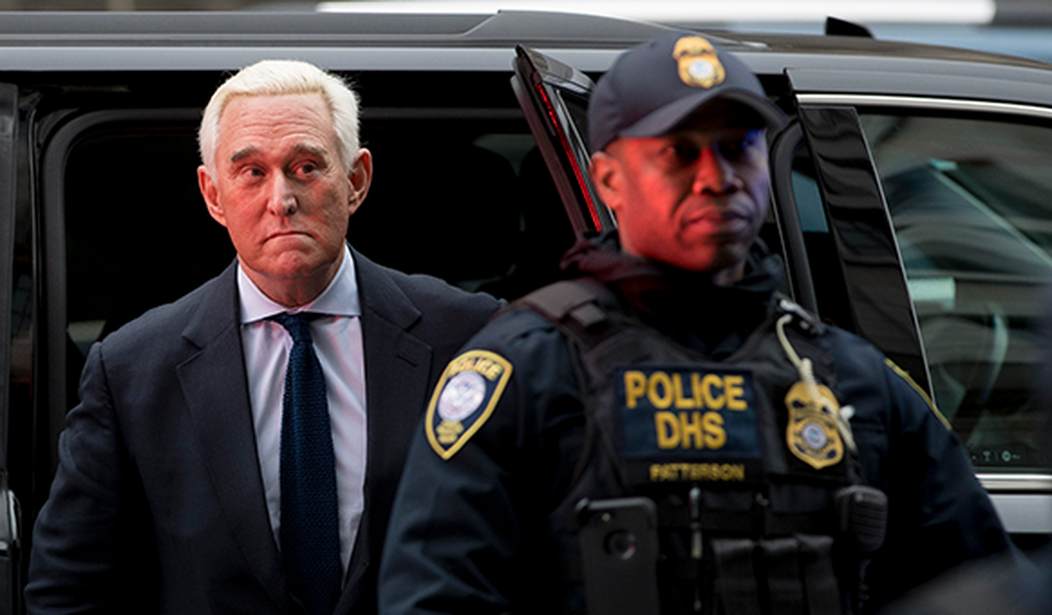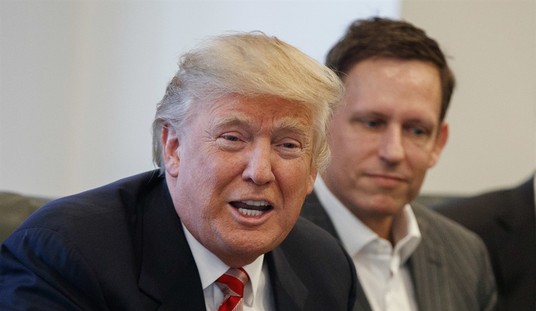
In Part One of this story I covered the question of “Who Were Those Guys” with regard to the four man Roger Stone “trial team” that emerged from the wreckage of the Special Counsel’s Office, needing assistance from the DC US Attorney’s Office Fraud and Public Corruption Section. I’m going to refer to them here as “Zelinsky & Company”
With 22+ years of experience doing the same job in my rear-view mirror, another 7+ years as a defense attorney exclusively in federal court, and hundreds more sentencing statements under my belt than any of the four members of the Zelinsky & Company – maybe more than all four of them combined — I’m saying to them “Your work showed your inexperience” when it comes to how they handled the sentencing phase of the Stone case.
Again — as I mentioned in Part One — this story is not about Roger Stone being innocent. This story is about the decisions and choices made by Zelinsky & Company, and what it said about the motives behind the prosecution of Stone, and the motives of the Special Counsel’s Office (SCO) as a group.
Last week in his opening statement to the House Judiciary Committee, Aaron Zelinsky portrayed himself and the other members of the Zelinsky & Company as agnostic adherents to DOJ sentencing policy. They were outraged by what they perceived to be illegitimate interference in the case when it was suggested to them that they were unjustly harsh with regard to their recommendation on the term of imprisonment he should serve. Zelinsky claimed that the “leadership” of the US Attorney’s Office and Main Justice — by which he was referring to Acting US Attorney Timothy Shea and presumably Attorney General William Barr, were “pressuring” Zelinsky & Company to remove the factual conduct section describing what Roger Stone was convicted of having done, to not seek an increase in his sentence based on threats he made to Randy Credico, and to remove completely the recommended sentencing range of 87 to 109 months. These were suggestions Zelinsky & Company, relying on their collective wisdom of less than 20 years total experience, thought could only be explained by political interference intended to please President Trump by giving his friend a break. After much interoffice debate on on February 10, they filed their sentencing statement without making the disputed changes — other the removing the factual statement — but leaving in the sentencing factors and sentence recommendation. The following day they learned that there had been a miscommunication between the US Attorney’s Office and the Attorney General’s Office about the expectations of changes being made to the sentencing statement. Zelinsky & Company were told that their sentencing statement was being withdrawn, and it would be replaced by one that was in accord with the Attorney General’s expectations. A Supplemental Sentencing Statement was filed by another prosecutor in the US Attorney’s Office who thereafter appeared at the Stone sentencing hearing after Zelinsky & Company refused to be involved and filed “withdrawals” from the case.
But the sentencing statement filed by Zelinsky & Company did not adhere to DOJ policies, and rather than “painting a picture” with analysis of the facts and the law, it was something closer to a “color by numbers” effort that mechanically went through all the steps they were taught to follow, but without understanding why they were doing them as they went along. Their work product incorrectly reflected a belief that it was their job to generate an analysis that resulted in the longest sentence that could be imposed on a 67 year old first time offender. In doing so they ignored the overriding command of DOJ Policy that federal prosecutors seek a “just sentence.”
The following is a bit of a “primer” on how federal sentences are arrived at, and the role played by prosecutors in that process.
An organization called the United States Sentencing Commission was created by Congress. The Commission evaluates the “relative” severity of the entire range of federal criminal offenses and creates a sentencing scheme designed to punish more serious offenses with longer sentences, and less serious offenses with shorter sentences. This is done with the creation of a numerical scale that has “1” as the least consequential number, and “43” as the most consequential number. The higher the number that ends up affixed to the crime for which you were convicted, the longer your sentence will be.
As a general matter, every federal crime has a “base offense level” assigned to it. Less serious crimes have lower “base offense levels” and more serious crimes have higher “base offense levels”. The “based offense level” is the starting point.
After the base offense level is determined, each crime has “offense characteristics” – a list of aggravating or mitigating factors that add levels to the base number, or subtract levels from the base number. You work your way through the guidelines by looking at the “offense characteristics” and then moving the base offense level up or down as appropriate depending on the facts.
After all the factors are applied – both up and down – you end up with an “adjusted offense level.” This is the number which the court uses to determine the range of possible sentences in the “Sentencing Table”, which are expressed in a term of months. So a range of “87 to 109 months” means the recommendation is for a sentence of 7 years and 3 months, to 9 years and 1 month. If the judge decides to sentence a defendant “within the guideline range”, the judge will pick a specific number of months between 87 and 109 – it is up to the judge to decide where in that range – and that specific number is the sentence imposed.
The first thing to notice about the prosecution of Roger Stone is that Zelinsky & Company – while working for the SCO and under the tutelage of people like Andrew Weissman — included one count of “witness tampering” along with a single count of “obstructing a proceeding” and six counts of making “false statements.” The crimes of “obstructing” and making “false statements” all have a maximum potential penalty set by Congress of 5 years. But the “witness tampering” count had a maximum potential penalty of 20 years.
By including “witness tampering,” the SCO created the potential for Stone’s actual sentence to be more than 60 years — without the “Witness Tampering” the maximum sentence authorized by Congress on the other crimes was five years. By including “witness tampering,” and its maximum authorized term of 20 years, the SCO increased Stone’s potential “exposure” under the sentencing guidelines by an additional 180 months.
That was a discretionary decision that belonged to the SCO. There is a DOJ policy that says a prosecutor “shall” charge the most serious “readily provable offense”, so it was not a direct violation of DOJ policy for the SCO to include the “witness tampering” charge. But opting to do so on Stone was reminiscent of the stunt they pulled – Zelinsky again I believe — on Papadopolous when he was arrested at Dulles International Airport outside Washington DC.
When George Papadopolous was intercepted — during a layover and plane change before flying on to his home city of Chicago where he had already retained counsel — he was removed from Customs and held in detention for a period of time. This was late July 2017. Papadopolous had been interviewed by the FBI five months earlier in February 2017 — long before the SCO came into existence. There was no DOJ involvement at that point, and Papadopolous and his attorney had remained in contact with the FBI.
There is some uncertainty whether the SCO was waiting for Papadopolous to MAYBE arrive with $10,000 cash he was given while in Europe, and whether he would declare it or not. Not everything Papadopolous claims to have happened in his book aligns neatly with other facts. He was not carrying any large amount of currency when he re-entered the US, so he didn’t declare any currency to Customs. But he was still detained at the airport for an extended period of time before being taken to the Federal Detention Center in Alexandria, to make an appearance the following day on a Criminal Complaint that was hastily assembled the night of his arrest charging him with having made “false statements” to the FBI in his Feb. 2017 interview. It has never made sense — and it still does not make sense — that the FBI and SOC intercepted Papadolopous at Dulles if they did not intend to arrest him. And if they did intend to arrest him it does not make sense that they did not already have a criminal complaint prepared and filed in advance, and have an arrest warrant in-hand. Instead they did something the FBI ALMOST NEVER DOES — they arrested him on “probable cause” which they claimed arose out of his Feb. 2017 interview. They took him to jail, while a prosecutor and an FBI Agent put together the criminal complaint, affidavit, and arrest warrant which were all presented to a judge and signed the next morning prior to his court appearance.
But when Papadopolous made his intitial appearance in the Eastern District of Virginia federal district court, he learned that the criminal complaint charged him not only with making false statements, but also charged him with “obstruction of justice” under 18 USC Sec. 1519, a crime which carried a potential penalty of 20 years in prison — just like witness tampering.
Papadopolous and his attorneys have both said publicly that he became fixated on the fear that he might go to jail for as long as 20 years, and out of that fear he waived his right to have his lawyer present and agreed to answer questions. It was the fear of a 20 year sentence – on a bogus charge (that’s another story) — which drove his decision to cooperate and later plead guilty.
Was the “witness tampering” charge included against Stone because he was a long-time friend and advisor to Donald Trump, and he had refused to cooperate with the Special Counsel? It seems to be a fair conclusion to draw that SCO had a pattern of using more serious charges to harass and intimidate their targets — people close to Pres. Trump — as part of their tactical plan to generate information to use against Pres. Trump. The same is true with respect to Gen. Flynn and the threat to charge him and his son with charges under the Foreign Agents Registration Act (FARA) if he did not agree to plead guilty to having made false statements.
Again, these are not unsual practices in federal prosecutions and they do not violate DOJ policy. But the SCO had a practice of employing threats of prosecution for more serious crimes against persons who were associated with, or friends of President Trump in trying to build a case against President Trump.
And it DOES VIOLATE DOJ policy to offer and enter into a plea agreement that does not include a guilty plea to the most serious “readily provable offense”. Section 9-27.430 of the Justice Department Manual states:
If a prosecution is to be concluded pursuant to a plea agreement, the defendant should be required to plead to a charge or charges:
-
That is the most serious readily provable charge consistent with the nature and extent of his/her criminal conduct;
-
That has an adequate factual basis;
-
That makes likely the imposition of an appropriate sentence and order of restitution, if appropriate, under all the circumstances of the case; and
-
That does not adversely affect the investigation or prosecution of others.
It is expressly against DOJ policy to charge a more serious crime, and then enter into a plea agreement for a less serious crime — EXCEPT where circumstances with regard to proving the more serious crime change after the charges are brought. It is AGAINST policy to use the presence of the more serious crime in an indictment as “leverage” to coerce a guilty plea to a less serious crime. It is AGAINST policy to drop the more serious crime as a reward for cooperation when the more serious crime was “readily provable.” The correct procedure for such a situation is for the defendant to plead to the more serious crime, and for the defendant’s sentence to be reduced by the judge as consideration for the cooperation provided based on the prosecutor’s recommendation. That is how the process is designed to work by multiple written DOJ policies — all of which applied to the SCO.
But the SCO did use the plea bargaining process in a manner not consistent with DOJ policy in the cases against Gates, Papadopolous, and Flynn at least. They were each “rewarded” in the form of having the more serious charges either dismissed or not pursued.
Roger Stone, on the other hand, had made it publicly known that he would never cooperate with the SCO in its effort to target President Trump.
Is it a coincidence that Roger Stone was treated more harshly by the SCO in its selection of charges brought against him because of his relationship with Trump?
It’s hard to come to any other conclusion — especially when we turn next in Part 3 to take a closer look into his sentencing.















Join the conversation as a VIP Member